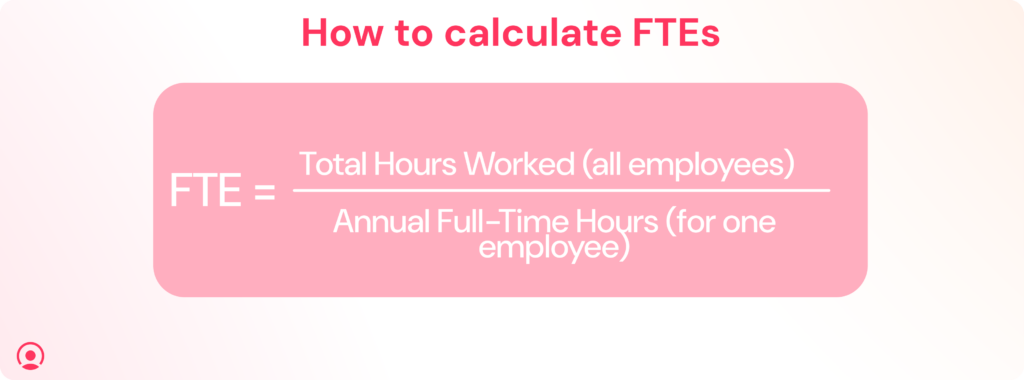What is the productive capacity of your company? In other words, do you know what the full-time equivalent is and how it can help you better understand the needs of your organization? If you don’t know what it means, you should, as this metric can help you make important decisions. Through the full-time equivalent calculation, it is possible to identify whether your small business needs to hire, restructure or reduce its staff, for example.
The full-time equivalent is an indicator that answers many of the questions Human Resources departments need to. This, therefore, allows them to make better decisions regarding personnel management. Want to learn more about what it is and how it can help you? Keep reading.
- What Does FTE Mean?
- Why Calculate the Full Time Equivalent?
- How to Calculate the Full Time Equivalent
- Full Time Equivalent Calculator
- ✅Time Off Management Software for employees
What Does FTE Mean?
First, let’s look at what full-time equivalent or FTE actually means. The full time equivalent, often abbreviated as FTE is an indicator that reflects an employee’s productive capacity. An FTE of 1.0, for example, corresponds to the hours worked in a day for a full-time employee. Consequently, the FTE for a part-time employee working 20 hours a week would be 0.5.
The full-time equivalent converts the hours worked by part-time employees into hours worked by full-time employees.
Like revenue per employee, this indicator is of great importance for strategic HR management. As they indicate how much manpower a company has. In other words: they allow you to calculate the real performance of a work team, a specific department, or the entire organization.
Example:
10 people are employed in a company. Five of them work full-time (40 hours per week), three occupy a part-time position each working 20 hours a week, and the other two each work 10 hours per week. The FTE or FTE value, in this case, is 7.0.
How to Calculate FTEs: Full-Time Equivalent Equation

A full-time position corresponds to an FTE of 1.0. Accordingly, 5 full-time positions result in an FTE of 5.0.
A part-time position (20 hours) corresponds to an FTE of 0.5. With three part-time positions, this results in a value of 1.5.
10 hours per week corresponds to an FTE of 0.25. With two 10-hour digits, this results in an FTE value of 0.5.
As you can see, the part-time employees are converted into the performance of a full-time employee. So the FTE is not the number of employees in a company, but the equivalent of a full-time employee. Because the number of employees says nothing about a company’s actual work performance.
Why Calculate the Full Time Equivalent?
The conversion of part-time employees into full-time employees provides information on the productivity of the company’s workers, whether by team or department. This has a number of advantages:
- Performance analysis: The full time equivalent helps to ensure effective employee performance management. With the FTE, it is possible to get a more accurate picture of how employees are performing. More important than knowing the number of employees in a company, is to understand their overall performance.
- Improved decision-making: With the calculated value, important HR decisions can be made. For the HR department, full time equivalent is therefore particularly important for annual HR planning and for managing labor costs. In this way, changes in teams and trends in the job market can be better assessed.
- Easier to plan new projects: Employees with different types of employment contracts can be more easily assigned to projects, as an employee’s performance can be better calculated – no matter how many hours they work per week.
- Respect for legislation: The FTE determines which employment laws and compensation laws apply within a company. Additionally, HR checklists for small businesses can help to stay on top of compliance with federal and state laws.
- Accurate comparison: The productive capacities of different companies and departments can be compared more easily with FTE. This is because if you compare only the number of employees, the results are very inaccurate.
Discover Business Management Software that helps your team do more.👇

How to Calculate the Full Time Equivalent
FTE can be calculated quickly in four simple steps.
Based on an FTE of 1.0, we calculate employees work 2,080 hours per year. This does not include holidays and days of absence. Furthermore, this value is used only as a basis for calculating the annual FTE and reflects the hours of an employee who works 5 days a week, 8 hours a day.
Full Time Equivalent Formula
It is possible to calculate the full time equivalent using the following simple formula:
(Total number of hours for all part-time employees + the total number of hours for all full-time employees) / period for calculation (2080 for annual FTE, 173.33 for monthly FTE or 8 for daily FTE ) = Final FTE
Divided into several clear steps, the account looks like this:
Step 1
First, it is necessary to determine the number of hours worked by part-time employees.
Formula:
Part-time employees x total number of hours per week x number of weeks (that an employee has worked) = total hours worked over the given time period
Example:
5 part-time employees work 25 hours a week for 30 weeks.
2 part-time employees work 10 hours a week for 25 weeks.
Account:
5 x 25 x 30 = 3750 hours
2 x 10 x 25 = 500 hours
To obtain the total number of hours worked by all part-time workers, add the two results together:
3750 + 500 = 4250 part-time
Step 2
Now determine the number of hours worked by full-time employees over a given period. Full-time employees are those who work a minimum of 30 and a maximum of 40 hours a week and more than 120 days a year.
Formula:
Full-time employees x working hours per week (40) x 52 weeks per year = total working hours of full-time employees per year
Example:
7 full-time employees work 40 hours a week
Account:
7 x 40 x 52 = 14,560 hours full time
Step 3
Now add the total number of hours worked by full-time employees to that of part-time employees to get the total number of hours for all employees.
Formula:
Total hours of full-time employees + total hours of part-time employees = total hours worked by all employees per year
Account:
4250 (part-time) + 14,560 (full-time) = 18,810 total hours

Step 4
In the last step, just divide the total number of hours of full-time employees and part-time employees (in our example 410 hours) by the number of regular full-time hours (in our example 2,080 hours per year or 40 hours x 52 weeks ) to generate the full time equivalent for a certain period of time.
Formula:
Total number of hours for all employees / 2080 = FTE
Account:
18,810 (total number of hours) / 2,080 = 9.04 FTE
To obtain the full time Equivalent for a month, divide the total number of hours by 173.33 (2,080 hours / 12 months).
For example, if the total number of hours in the month of March were 2,800, the account would look like this:
2,800 (total number of hours) / 173.33 = 16.15 FTE (FTE)
To find the equivalent of a full-time day, divide the total number of hours by 8.
For example, if the total number of hours were 75, the calculation would look like this:
75 (total number of hours) / 8 = 9.38 FTE (FTE)
The result is the full-time equivalent of 9.04. With 14 employees, 7 of which are full-time and 7 part-time, the staffing capacity is 9.04 full-time employees per year.
Full Time Equivalent Calculator
If you want to save time, why not use our free full time equivalent calculator template for excel to easily work out your company’s FTE.
Just indicate how many employees work at your company, how many hours they work a week, and for how many weeks. Our model will then instantly calculate the Full Time Equivalent for you.
Do you want help with the management of your company’s key figures, helping your team make the right decisions, and implementing the right measures in personnel planning? Then Factorial is the best option for you.
FTE FAQs
What’s the difference between full-time equivalent and headcount?
Headcount refers to the number of employees you have at your company, without taking into consideration if your employees are part-time or full-time. On the other hand, full-time equivalent refers to the equivalent number of full-time employees at your company.
What does FTE stand for?
FTE is the acronym for full-time equivalent and is used to determine the overall number of full-time hours or full-time employees that are on your team.
What do 0.5 FTE and 1 FTE stand for?
FTE 1 refers to one single full-time employee, where a part-time employee will have an FTE score of 0.5, which represents half of a full-time employee.


